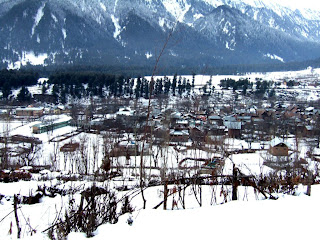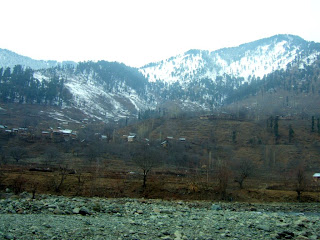
Pahalgam is a premium resort in Kashmir Valley almost 100 km away from City of Srinagar . It situated at the convergence of Lake Lidder and Sheshnag with a height of 2130 meter. It was ruled by Mughals at medieval period and later came under the reign of local Hindu Kings as part of Kashmir Kingdom. The hill station which used to serve as a village of shepherds, remains unspoiled and untouched by the ravages of progress of the modern world. At mid-April in spring, Baisaran meadows nested in the thickly wooded forest of pine extended to as far as 5km, giving a presentation of a wonderful picturesque view of the snow-clad mountain. While in Mid- November, Crocus Sativus (saffron flowers) formed a world of violet in mountain slopes. But most visitors came within July/August for pilgrimage during annual Amarnath Yatra to holy cave which was believed to be the abode of Lord Shiva. Pahalgam was said to be one of the most beautiful places in the world and is a paradise on earth.


Villages in Pahalgam are set between steep hills. The best way to have a spectacular sight of the valleys in winter season is pony trekking or horse riding. We were ready to explore into it.


It took us about two hours on horse back to have a brief sight of the valley and it was indeed a great experience.


Galloping along the pathway, crossed over bridges and streams, we enjoyed the breath taking scenery and the extreme calmness in the air.


These tourists huts at the hill station were not available in winter as it was too cold and too dangerous to put the nights on when sometimes there were heavy snow fall during the season.


Immersed in the whistling air inside the soaring mountains with dense pine forest, we became not aware of the coldness in this severe winter weather.


Lidder river runs through Pahalgam in a rushing gray-green torrent with curling waves against the stones and borders along its way.


The water of stream running from Lake Lidder and Sheshnag, passed through villages.



There are more than eight tiny villages inside the valley. One of the villages called Mamal, houses an ancient Shiva Temple dating back to 5th century.



We went through some of the Shepherd's villages to feeling their peaceful and contented life style




Villagers continued generations by generations, occupied this piece of pure land on earth, never ever would have the desire to leave.


Though most of the places were covered with thick white snow, children had their way to enjoy at leisure. Skiing , golfing and playing cricket were their common exercises in the cold air at the open space on the snow surface inside the valley.




This corner of world is greatly shortage in materials, but gifted with incomparable beauty of nature. The God is always fair.



Horses are the essential and valuable property in terms of transportation for villagers.




Snow capped peaks framed with blueish green pine forest.



We were suffocated with this 360 degree of spectacular views.


The rugged charm of nature, wild and genuine.


Pahalgam acts as the best take off point for trek into the surrounding mountains.




It is a home land for pine or fir kind of coniferous trees and a free land for wild lives.


Remarkable landscapes and beautiful nature view of scenery captured our sight as well as our breath. Our mind did not have time to wandering around in unnecessary issues of human life..



The little tiny mosque looked so cute in the midst of vast area of blueish mountain, greenish pine forest and white snow.



A scenic view of Himalayan ranges.



Silvery streams of ice water from glistening glaciers flowing by or cutting through villages at the valley.






The scenery is so natural and attractive as if huge piece of painting hanging down from the sky at the edge of earth.




Every sight under your eyelid are beautiful mountainous scenery like this.



An ancient Cave Shrine Aishmuqam at Mattan along the scenic way to Kashmir Valley.


A peaceful world of living.





The stream, the stone and the unknown red trees creating a screen of beauty.




A farming village at the foot of the mountains.


A site of rare flat farming area.


Pahalgam is the only place in Asia that produce Saffron which has been a well-known spice as a natural seasoning and coloring agent for food or for painting or used as dye stuff, for more than 3000 years. Habitat of Saffron is definitely in Kashmir where people grew it principally to offer to Buddha 2550 years ago, and many monks used to dye their robes with it in early century. It was believed that Saffron has some medicinal applications such us treatment for melancholy, to cure headache, or used as therapectic drug. Being bitter in taste, the spice imparts a rich golden yellow hue especially to dishes and textiles. Today, it is widely used in the cuisine of Iran, Arab, India, Turkey, Central Asia and Europe.



Saffron is a spice derived from the flower of Saffron named as Crocus Sativus. Each flower bears 3 stigma with stalk connecting to the plant and when flower withered away, stigma is picked and dried to become Saffron. One kg of saffron required 100k to 150k flowers and an area of cultivation of two football fields, with intensive laboring. The cost varies from 5-10k US dollars per kilo. It is the most expensive spice in the world, more costly than gold. They export saffron and at the same time import in healthy dried fruits from middle east like raisin and figs


Saffron are best planted in fields slope towards sunlight. As a sterile triploid form, Saffron flowers do not produce viable seeds for reproduction but depend on human's assistance. Farmers dig out its underground starch storing bulb (4-5 cm in dia.) known as corm, and broken apart to as many as 10 divisions and replanted onto ground in summer . A corm survives for only one season. Saffron purple buds appeared in Autumn after cultivation in June. The plant grew into a height of 12 inches upon flowering in the month of October and the flowers developed from a pastel shade of lilac to a darker mauve color and died off few days later.



Rice field and farm after harvested. Kashmir produce kind of special healthy rice which was quite different from other part of Asian. We enjoyed Basmati rice of India more.






A picturesque scene of local villages at the hill slopes.


We obtained some local produces like saffron from this busy local market.




Religion sites along the way (1) Remaining of ancient mosque (2) Tibetan styled mosque and (3) Modern little mosque.



Display site of military trucks along the road.


(1) An Artistic Indian calligraphy written road sign (2) English written signboard from petrol kiosk (3) Like most parts of India, heaps of golden cow dung was also an eye-catching scene at country side.



Vast area of Mulberry trees are planted for silkworms as Kashmir silk are the main and native products of Kashmiri


Pahalgam provide the best cricket bat in the world made from poplar wood which are widely grown within the area.2 move down



Roads are bordered by rigid avenues of poplar trees.



Stone carving is also one of the cottage industries popular in Kashmir. All items are hand-made without machinery.




A quiet and serene country side along the way back to Srinagar.








Thanks for sharing these wonderful pictures , These are awesome . Kashmir is really incredible . Kashmir holiday Packages
ReplyDeleteIts very nice post. Thanks for sharing content and such nice information for me. I hope you will share some more content about Please keep sharing!
ReplyDeleteJim Corbett Resort